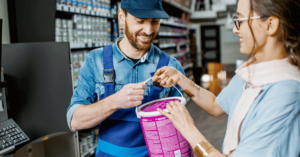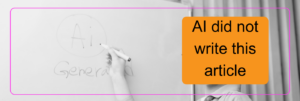Last week, I talked about some of the harsh realities of competing for B2B loyalty. Today, I want to share some research and insights on what you can do about those realities. Here are five B2B customer experience best practices I suggest for staying competitive and customer-centric in today’s B2B challenging markets:
Help & engage customers with live chat.
Live chat can provide B2B customers the self-service they’re looking for and improve your digital experience. As a McKinsey study found,
33% of buyers surveyed rated the option of live chat during the research stage of their buying journey as one of the top-three requirements for a best-in-class supplier.
There are lots of options for adding a live chat feature to your website. Drift and Hubspot both offer live chat tools that integrate directly with CRMs like Salesforce.
A word of warning: use bots with caution! It can be tempting to load up a chat bot with answers every question you can imagine or request contact info. But that’s not necessarily B2B customer experience best practice. A PWC study found that 64% of U.S. customers think companies are missing the human touch when it comes to customer experience, and 71% would prefer human interaction to talking with a chatbot. Use bots where they are most useful and discontinue their use if you notice poor results.
Make your website more useful to B2B customers.
A useful, easy-to-navigate website is one of the most crucial B2B customer experience best practices. Customers researching your company, looking for answers to questions about your products, or looking for a self-service option are likely going to start with your website. There’s a one in three chance they’re not finding what they’re looking for. McKinsey’s B2B study found that decision-makers’ most frustrating issues with suppliers’ websites include:
- The length of the ordering process (36%)
- The difficulty of finding products (34%)
- Glitches when ordering (33%)
Live chat provider Drift conducted a similar study of B2B buying experiences and found one that the Inability to get answers to simple questions is one of customers’ biggest frustrations.
These stats offer great direction on where to start with your website improvements. Don’t lose sight of why customers are visiting your website. Most likely they want to find a way to contact you, find information about your products or services, or troubleshoot issues.
There are several things you can do to improve your website’s usefulness to B2B customers:
-
- Simplify your navigation so it’s obvious they can find what they need. Don’t sacrifice navigation for appearance—a clean, clear menu is more important than flashy design.
- In addition to a live chat for support and questions, provide a search bar. This will not only improve the B2B customer experience by allowing them to search for exactly what they’re looking for, but you can store and analyze these search queries to better understand what your site visitors are looking for.
- At least half of your web traffic comes from mobile devices, so perfect the mobile version of your site.
- Use heatmap tools like Hotjar to find out where B2B customers are clicking and tapping on your website. This can show you where they expect links or interaction to be, where they’re getting side-tracked, etc.
- Utilize single-sign-on (SSO) functionality. If you have multiple websites, stores, or loyalty programs associated with your company, connect those sites to a single domain so visitors can get almost anywhere they need to go from a single online location.
- Don’t make guesses about where your website’s issues are. No one in your company can provide an objective opinion. Conduct user testing to find out what visitors—ideally your target audience—really think about your site.
- Give visitors the ability to instantly schedule appointments with the experts they need to contact. Tools like Calendly can sync with your Outlook or Google calendars so they can quickly find an open time that works for them.
Personalize B2B customers experiences and communications.
The Drift study I mentioned earlier found that, from 2019 to 2020, B2B customers reported a 5.7 increase in frustrations with brands being unresponsive on social/email and a 2x increase in frustrations with services that felt impersonal.
Think about it from a B2B buyer’s perspective: what’s one of the biggest benefits of conducting repeat business with a supplier? The supplier’s history and familiarity with you. If they feel like a stranger when interacting with your company, it doesn’t exactly inspire those feelings of familiarity. Some of the things you can do to personalize communications include:
-
Use tokens, dynamic content, and audience segmenting in marketing messages.
Tokens and dynamic content are marketing automation software tools that allow you to swap out select content in your emails and webpages according to what’s relevant to that individual customer. Segmenting your marketing audiences by region, interests, or product purchase history helps you deliver them the information and content they care about, not just one-size-fits-all blasts. When B2B customers visit your site or receive your emails, they feel seen and heard.
-
Segment your offers, discounts, sales promotions, and incentive program pay-out.
Dealers in different climates will have different levels of need for heating and cooling products, for example. With today’s segmentation tools, you can tailor offers and incentives to appeal to different B2B customers.
-
Funnel all your customer data into one source.
If you use multiple different pieces of technology to interact and manage your customers—from a CRM to a customer service platform to an incentive program—you should be pushing all that disparate data into one place so you have a complete customer profile.
Communication and marketing software is great for quick and bite-sized personalization, but don’t forget that the best form of personalization is the oldest: one on one connections. That’s the highest and most inimitable form of personalization and customer loyalty.
Connect B2B customers to helpful info without being a data-dumper.
It’s possible to have too much of a good thing. With so many options available, so much information at hand, and an increasing number of people involved in buying decisions, B2B customers have begun to feel overwhelmed by information. This paralyzes the decision process. Rather than shoving case studies, white papers, and product specs down customers’ throats in the beginning, find out more about the customers’ needs and determine what information is useful and relevant to them. As a Gartner study found,
The sales reps most likely to win in this world are far less focused on demonstrating personal expertise by dumping yet even more information into customer interactions, and far more focused on helping customers sort through information already available —acting as a kind of ‘information connector’ to provide the frameworks and tools customers desperately need to efficiently organize and align their thinking.
Aim for customer confidence, not just customer satisfaction.
The vast majority of customers are already satisfied with their current suppliers, and focusing on satisfaction doesn’t drive account growth.
So what does drive B2B account growth? Customer confidence. The same Gartner study I mentioned above found that, when customers feel confident in their ability to make good buying decisions, account growth is 2.6 times more likely. Gartner defines decision confidence as the customer’s belief that they can anticipate necessary changes, determine the right questions to consider, and make the right choice.
The best way to build customer confidence is to act as a valued partner, not just a supplier. I endorse these suggests made by Lauren White of 3Aspens Media:
-
- Offer customers additional videos and spec material of your products.
- Suggest ways they can cut costs or get more out of a product they already have.
- Help them find out whether their purchase qualifies them for a tax credit.
- Solve customer issues even when they’re not profitable to solve. What else could better show that they made the right choice doing business with you?
Whether your customers have purchased from you once or two hundred times, they are always free to take their business elsewhere. Continuously make yourself a helpful, informative, and convenience resource to your customers and they’re less likely to look elsewhere.
Genuine relationships are at the heart of all B2B customer experience best practices. Have conversations. Ask questions. Be real. And, most important, actively listen to customers. Companies like GE Additive, for example, have customer experience centers where B2B customers partner with representatives for personalized collaboration. They can see manufacturing products in action and find the right solutions for their business. Initiatives like this that build strong, personal, one-on-one connections to customers, will be your most effective customer experience strategy.
Are you one of the many unlucky manufacturers or suppliers whose customers are indifferent to you? Gallup estimates that 71% of B2B customers are indifferent or actively disengaged. How can you grab their attention in a meaningful, effective way, not a desperate, cringey way? Check out this infographic for more information, and five suggestions for providing a better B2B customer experience that engages and excites your channel.

1. Segmentation
Divide groups by performance, location, vendor type—whatever is useful to you.
Create sales promotions, marketing campaigns, sales strategies, around channel partner segments.
69% of B2B buyers say they find more value in vendors who provide personalized offers.
2. Personalization
Use tokens in marketing content to personalize messages.
Add dynamic content blocks to email and web interactions.
Create different permission sets within your channel partner portal or incentive program.
76% of B2B buyers expect personalized attention from solution providers based on specific needs.
3. Engagement
Use non-cash rewards to excite and motivate channel partners.
Add gamification elements to incentive and sales promotions.
Shake channel partners out of their daily routine with engaging corporate and group events.
71% of B2B customers are indifferent or actively disengaged.
4. Education
Create a sales enablement process to provide resources and assets to channel partners.
Use training incentive rewards to motivate channel partners to develop product knowledge.
Only 35% of companies have effective training for channel salespeople.
5. Incentives
Drive any behavior and enhance any promotion or campaign by offering non-cash rewards.
Tap into emotion and personal value.
Incentive programs can boost performance by 25-44%!
Sources
1. Pros: What B2B Buyers Want
2. DemandGen: B2B Buyer Behavior Study
3. Gallup: B2B Customers Are Indifferent
4. Brainshark: Channel Enablement
5. The People Project
6. The IRF: Incentives, Motivation and Workplace Performance



